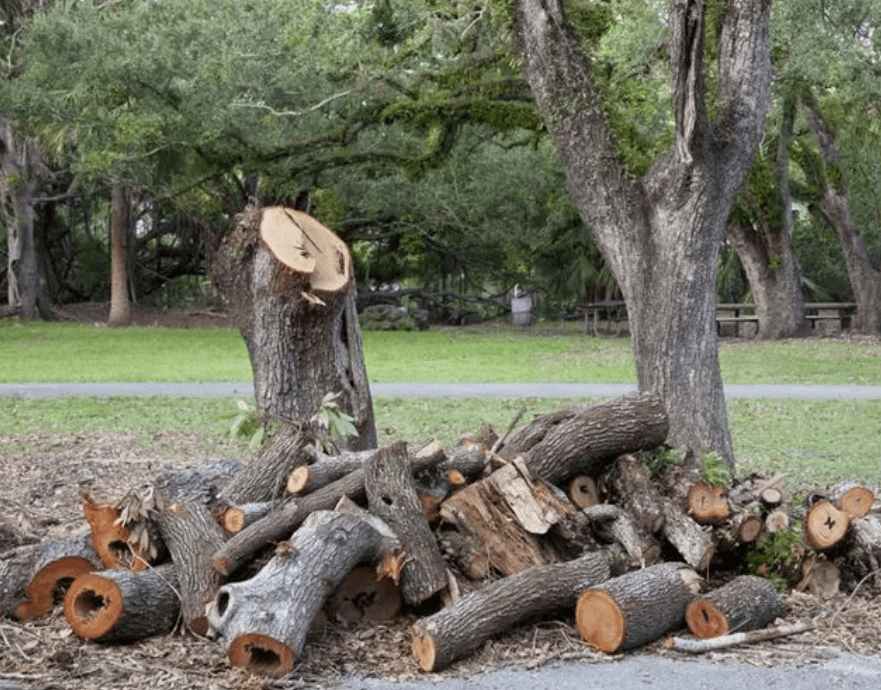Tree Removal, the very thought of removing a tree from your backyard might evoke a mix of emotions. Trees are often seen as majestic, life-giving entities that add beauty and serenity to any landscape. However, strategic tree removal can sometimes lead to unexpected and highly beneficial transformations for your backyard. Here are five surprising reasons why tree removal can be a game changer for your outdoor space.
Tree Removal Will Enhance Natural Light and Space
Tree Remoal Will Boost Sunlight Penetration
One of the most immediate effects of tree removal is the increase in natural light. Large trees, especially those with expansive canopies, can cast significant shadows, limiting the amount of sunlight that reaches your backyard. Removing these trees can instantly brighten up your space, making it feel more open and inviting.
Creating More Usable Space

The physical space occupied by a large tree can be substantial. Once removed, this space can be repurposed for a variety of uses, such as a new garden, a play area for children, or even a cozy outdoor seating area. This newfound space can significantly enhance the functionality of your backyard.

Improving Views and Aesthetics
Without the obstruction of large trees, you might find that your backyard has a better view than you realized. This could include a clearer view of the sky, which can be particularly enjoyable for stargazing, or an unobstructed view of a beautiful landscape beyond your property.
Promoting Healthier Landscape
Reducing Competition for Resources
Trees, especially large ones, compete with other plants in your garden for resources like water, nutrients, and light. Removing a tree can alleviate this competition, allowing your other plants to thrive. This can lead to a healthier and more vibrant backyard ecosystem.
Controlling Pests and Diseases
Some trees may become breeding grounds for pests or be prone to diseases, which can spread to other parts of your garden. Removing such trees can help control pest infestations and prevent the spread of tree diseases, thereby protecting the overall health of your backyard.
Encouraging New Plant Growth
With the removal of a tree, you have the opportunity to introduce new plant species that were previously not viable due to space or light constraints. This can add diversity to your garden and encourage a more balanced ecosystem.
Increasing Property Value
Enhancing Curb Appeal
A well-maintained backyard with strategic landscaping, including tree removal where necessary, can significantly enhance your home’s curb appeal. This not only makes your property more attractive to potential buyers but can also increase its market value.
Improving Safety and Accessibility
Removing potentially hazardous trees, such as those that are dying or are too close to your home, can make your backyard safer. This not only protects your property but also makes it more appealing to families with children or pets.

Making Room for Modern Landscaping Trends
Modern landscaping trends often emphasize minimalism and functionality. Removing certain trees can help create a more contemporary look and feel in your backyard, aligning your outdoor space with current trends.
Conclusion and Further Study
Removing a tree from your backyard can be a significant decision, but it can also unlock a range of benefits, from increased natural light and space to a healthier landscape and higher property value. Before making any decisions, it’s important to consult with a professional arborist and consider the ecological impact.
Understanding the ecological impact of tree removal is essential for maintaining a balanced and healthy environment. Trees play a critical role in our ecosystems, offering a range of benefits to both the environment and the species, including humans, that inhabit it. When considering tree removal, it’s important to be aware of these ecological impacts:
- Carbon Storage and Climate Change: Trees are vital in combating climate change as they absorb carbon dioxide, a major greenhouse gas, from the atmosphere. Removing trees reduce this carbon absorption capacity, contributing to increased atmospheric carbon levels and potentially exacerbating climate change.
- Habitat Loss: Trees provide crucial habitats for a variety of wildlife, including birds, insects, and small mammals. Removing trees can lead to habitat loss, which can disrupt local ecosystems and biodiversity. The loss of certain tree species can have a particularly significant impact if they are host to specific wildlife.
- Soil Erosion and Water Cycle Disruption: Trees play a significant role in maintaining soil structure and fertility. Their roots help to hold soil in place, reducing erosion. Additionally, trees influence the water cycle through transpiration, contributing to atmospheric moisture. Tree removal can disrupt these processes, leading to soil degradation and altered local water cycles.
- Microclimate Regulation: Trees help in regulating the microclimate of an area. They provide shade, reduce temperature extremes, and act as windbreaks. Their removal can lead to higher temperatures and increased wind speeds in local areas, which can affect both human comfort and the growth conditions for other plants.
- Ecological Connectivity and Pollination: Trees often serve as ecological corridors or connectivity pathways for wildlife, especially in urban or fragmented landscapes. They also support pollinators like bees and butterflies. Removing trees can disrupt these ecological pathways and affect pollination services, which are essential for many plants, including food crops.
- Aesthetic and Psychological Impact: Beyond their ecological roles, trees contribute to the aesthetic value of landscapes and have been shown to offer psychological benefits to people, including reduced stress and improved mental well-being. Tree removal can thus have indirect ecological impacts by affecting human interaction with and perception of their environment.
When considering tree removal, it’s important to balance the immediate benefits with these potential ecological impacts. In many cases, these impacts cachoosing the appropriate species for the local ecosystem be mitigated by replanting trees, choosing appropriate species for the local ecosystem, and taking a careful, measured approach to landscape changes. Collaboration with environmental experts and arborists can ensure that tree removal is done responsibly, with minimal ecological disruption.